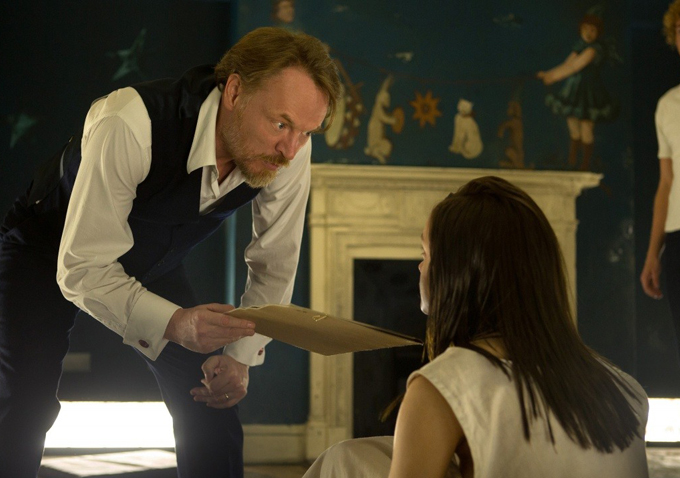
It used to be that you knew what you were going to get if you were watching a new horror movie produced by the British studio Hammer. Back in the ’50s, ’60s and ’70s, Hammer was responsible for a string of successfully stylish scary movies, many of them starring Christopher Lee and Peter Cushing. These were movies that were known for their emphasized artificiality and outrageousness—they were theatrical, provocative and bold; much sexier, funnier, and more colorful than their stateside cousins. So it’s even more disappointing that Hammer’s new movie, “The Quiet Ones,” the latest in a handful of releases the company has put out since their reorganization in 2007, is so drab and flavorless. While the movie is not without its charms, there’s nothing indicating that it’s actually a Hammer movie.

“The Quiet Ones” takes place in the mid-’70s, when a professor at Oxford named Coupland (played with a wily sense of determined purpose by Jared Harris) is trying to prove that the supernatural does not exist. His theory is that psychic phenomena is produced by disturbed individuals, and at one point suggests that curing a young girl (Olivia Cooke) will cure mental illness for the entire world (how, exactly, is left purposefully fuzzy). After the university balks at funding his research because, let’s face it, it’s pretty kooky and about as scientific as a séance, he retreats with a pair of grad students (Erin Richards and Rory Fleck-Byrne) to a spooky old manor to continue the morally questionable experiments in secret. He’s also brought along his de facto documentarian (Sam Claflin), a kid who isn’t a student but just part of the school’s AV department, to chronicle the weirdness that will inevitably unfold.
As far as set-ups go, it’s not too shabby. And you can see where the story could have gone in more gifted (or adventurous hands). But the story just doesn’t have any meat (ectoplasmic or otherwise) on its bones. The screenplay is credited to four different writers, including Oren Moverman (and honestly, who wouldn’t want to see a whacked-out ghost story by the guy who gave us “Rampart?”), although with each subsequent iteration the essence of the movie seems to have been diluted, not refined. The final version has been largely fashioned by co-screenwriter and director John Pogue, a filmmaker whose most notable works have been the direct-to-video sequels to “The Skulls” and “Quarantine.”

Pogue does away with any introductory context or character development, instead starting the movie in one of Coupland’s lectures (which sort of makes sense later for incredibly convoluted reasons) and running full steam from there. It’s like he thought that if the movie was just cut at a quick enough pace then the audience wouldn’t realize how little was actually there. The movie is augmented with what is supposed to be sequences shot on 16mm, although the aspect ratio seems to be off (Wes Anderson would not approve), in an attempt to approximate Claflin’s footage. Recently someone from Lionsgate (the stateside distributor of “The Quiet Ones”) tweeted that it took something like 14 processes to recreate the 16mm look. As someone quickly pointed out though, Why not just use 16mm? (The effect does little to enhance or heighten what’s going on in the movie; instead it’s just an empty flourish.) With a 93-minute runtime, the movie is over before it began. But maybe that’s a good thing.
All of this goofiness—the house, the “possession,” the hastily edited montage where a character discovers the young girl’s connection to an ancient cult—would have been a lot more palpable if they were in keeping with Hammer’s history of rollicking fun. But everything in “The Quiet Ones” is so dour, from its earthy ’70s color scheme to the fact that it rigidly adheres to its PG-13 rating (even when the adorable and talented Cooke climbs out of a bathtub—no boobs for you). The spirit of Hammer was always a bit anarchic and off-the-wall, with corsets stuffed with heaving bosoms and mad scientists’ lairs filled with beakers full of brilliantly Technicolor liquids and goo. Earlier entries in the Hammer resurgence like “Let Me In” and “The Woman in Black” felt like they were paying homage without ever turning into dusty pastiche; they felt like rightful heirs to the Hammer throne. “The Quiet Ones,” unfortunately, does not.

There is, however, one aspect where “The Quiet Ones” adheres to the company’s reputation (besides the period setting), and it’s very much appreciated. Hammer has always been fearless when it comes to thorny gender politics and investigating aspects of sexuality that many found uncomfortable at the time. And there is a little bit of that here, too. The movie, at its most basic level, is a story of possession, with a young girl overwhelmed by supernatural strangeness. But it’s also a story of possession in the way the men in the story treat the young woman, with both Coupland and his young photographer trying to save her, in ways that feel uncomfortable and deeply sexist. The fact that she clearly has the power, otherworldly or otherwise, isn’t even something that they consider. Why should she be able to help herself when there are all of these men fighting for her affection in increasingly creepy ways?
Of course, this is all underneath the surface, with very little screen time actually devoted to the discussion. Instead, there’s a sequence where a giant ball of ghostly goo shoots out of Cooke’s mouth, and some random murders take place. The movie does have some nice takeaways, mostly to do with Harris’ gleefully unhinged performance (he spends the entire last act of the movie in blood-soaked pajamas), but they are few and far between. The movie is, instead, perfectly adequate, which is never how a Hammer movie should be described. [B-]

